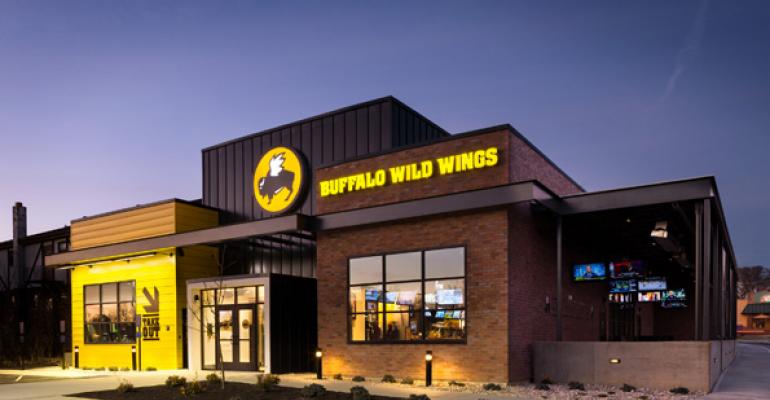 This post is part of the On the Margin blog.
This post is part of the On the Margin blog.
Refranchising has been de rigueur in the restaurant industry for roughly forever. Numerous chains, including McDonald’s, Wendy’s, Applebee’s and others, have opted to sell company-owned restaurants to franchisees as part of turnaround strategies.
Yet refranchising is neither a panacea for whatever ails a restaurant chain, nor is it a necessity for a chain to turn around sagging fortunes.
We say this because of the current proxy fight involving Buffalo Wild Wings Inc. and Marcato Capital Management. The investor has been pushing for changes at the chain since last year, and wants the company to sell the vast majority of its 634 company-owned restaurants.
Restaurant companies have steadily decreased unit ownership over the years, and that’s especially true for large, publicly traded chains where investors have been quick to push franchising.
Franchisees operate 76 percent of locations in the 100 largest chains, up from 75 percent two years ago, according to NRN Top 100 data. The change is even greater if we narrow the list to focus only on publicly traded companies that currently franchise. Franchisees operate 86.6 percent of locations in those systems, up from 85.2 percent just two years earlier.
The business of selling the right to operate a franchise is more profitable than the business of selling food to customers. Franchises, after all, don’t have to pay for things like restaurant buildings and equipment, and they don’t have to pay the salaries for large numbers of low-skilled workers.
As such, franchises get higher multiples on Wall Street than companies that operate more locations.
There’s little doubt Buffalo Wild Wings could refranchise all of its restaurants in a relatively short period. Operators have access to capital and an eagerness to expand, and would probably pay the company a fair price.
The problem is that, for all the refranchising strategies chains employ, it is surprisingly less common in the casual-dining segment in which Buffalo Wild Wings operates.
Only 10 of the 34 publicly traded chains that franchise are casual-dining or family-dining concepts, but only six of those are active franchisors, and only four — Buffalo Wild Wings, Applebee’s, IHOP and Denny’s — do so as a primary strategy.
A decade ago, IHOP bought Applebee’s and then proceeded to execute just such a quick refranchising that Marcato is proposing. It operates none of the chain’s 1,800 locations. Meanwhile, rival Chili’s went in the opposite direction, acquiring franchisees. It franchises just 300 of the chain’s 1,200 locations.
The results at Applebee’s parent company, DineEquity Inc., have demonstrated why investors like refranchising so much. Investors have given DineEquity a modestly higher valuation — it has an enterprise value multiple of 8 times earnings before interest, taxes, depreciation and amortization, or EBITDA, compared with about 7 for Chili’s parent Brinker International Inc. DineEquity has much higher operating and profit margins than Brinker.
Yet Brinker’s net income is more than twice that of DineEquity’s. It has more cash to pass on to shareholders, or to fix things when sales get problematic.
And Brinker’s five-year stock price performance has easily outdistanced DineEquity. Brinker’s stock is up 26 percent over the past five years. DineEquity’s stock is up just 5 percent.
By comparison, the NRN Restaurant Index is up 71 percent over that period.
Both companies are well off highs they enjoyed in early 2015, but DineEquity has lost more than 60 percent of its value since February 2015, while Brinker has declined by a third over that period.
To be sure, Applebee’s recent problems have little to do with the fact that it doesn’t operate any locations. The chain made a major blunder last year when it shifted to wood-fired grills and hand-cut steaks and didn’t market the strategies properly. (That said, some might argue that it would have tested the strategy more carefully if it was in the business of operating restaurants, but I've seen plenty of failed tests at companies that do operate their own locations.)
Still, the experience was enough to give proxy rating firm Institutional Shareholder Services pause when talking about Marcato’s plans for Buffalo Wild Wings. “DineEquity’s experience with Applebee’s does not appear reassuring to Buffalo Wild Wings’ shareholders,” ISS wrote.
Here’s another example: TGI Fridays. The casual-dining chain refranchised more than 140 locations two years ago, reducing its company-operated percentage from 40 percent to 11 percent. Estimated sales per unit over that time fell by more than 17 percent, according to NRN Top 100 data.
To be sure, quick-service concepts that have refranchised have a much better record of performance. But casual dining-chains are more complex. The restaurants themselves cost more money to open and to operate.
They also have lower profit margins. And franchisees have to pay a percentage to their franchisor in the form of royalty payments.
Here’s one more thing: Refranchising strategies aren’t necessary for companies to turn things around. In 2014, the activist investor Starboard Value urged casual-dining company Darden Restaurants Inc. to examine franchising as part of its turnaround strategy.
Darden didn’t do that, opting instead to spin off some real estate while concentrating its attention on a novel concept known as improving operations at the restaurant level.
The company's stock is up 50 percent since the end of 2014.
Jonathan Maze, Nation’s Restaurant News senior financial editor, does not directly own stock or interest in a restaurant company.
Contact Jonathan Maze at [email protected]
Follow him on Twitter: @jonathanmaze





